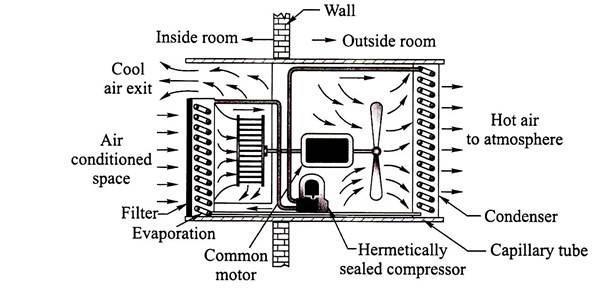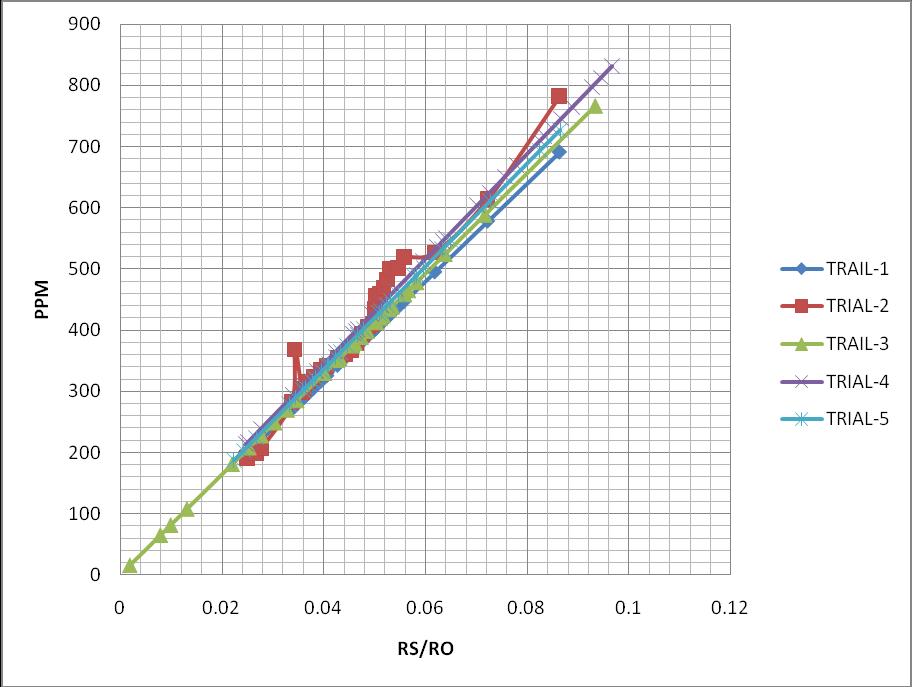

SENSOR BASED AIR QUALITY CONTROL IN AIR CONDITIONER
SARAVANAKUMAR M1 , NAGARAJ A2
1,2Lecturer, Department of Mechanical Engineering, PSG Polytechnic College, Coimbatore, Tamilnadu
Abstract – Air conditioners are turning out to be one of the most essential conditions for any ménage or assiduity to give comfort and better air quality. Air quality is a measure of how clean or weakened air can be which is bad for our health and health of the terrain. Air quality is measured according to the situations of different feasts present in the atmosphere. Detector grounded air quality regulator is used to measure the situations of colorful feasts using the MQ- 135 detector and allows us to maintain the air quality in the handed atmosphere. It helps us to not only maintain the air quality, it also enables us to remove the bank produced by burning incense sticks, cigarettes etc., The detector senses and monitors the quantum of feasts present in the room and sends the information to the Internet of effects( IOT) which controls the suckers present in the room. This sucker pumps out the old air from the room and pump in the fresh air from the outside terrain and also ensures to maintain the same temperature in the room. Then, IoT is used to give the information about the situations of feasts present in the room to the stoner via the android grounded operation which is developed with the help of MIT app innovator. The primary end of this system is to give and maintain a common standard of high inner air quality and a productive and comfortable place of work for all the people inside the room.
Key Words: Air conditioner, Detector, Internet of things, Innovatoretc,.
1. INTRODUCTION
Properventilationisthemostessentialrequirementfor any room and hence the ventilation system has to be designed properly. The Fig. 1.1 shows that the ventilation systemisdesignedinsuchawaytopreventcontaminants andaidsinremovingcontaminantsfromtheinteriorsource. Aventilationsystemhasseveralkeycomponentsincluding contaminantsource,anexhausthood,airmover,ductsand Fittings,makeupairexhaust,airpollutantsremovaldevice, dischargestackandairre-circulation.

(IMAGECOURTESY:SCIENCEABC.COM)
Therearethreetechniquesforthecontrolofindoorair pollutants dilution, extraction and source control. The following are additive control to reduce the indoor air pollutants:
Elimination,removalsubstitutionatthesource
Filtrationandcleaningofcontaminants
Indoorventilation
Encapsulationorinterferingwiththematerialability togiveofairpollutants
Isolation by space distance or time of use of potentialcontaminant
Awarenesstothebuildingofoccupant’soperations undermaintenancepersonnel
Indoorairqualityisaffectedduetothefactorssince,the building fabric, furnishings and equipment, occupants and their activities produce pollution. In an inactive building, someoftheseairpollutantsmayhavedirectlyexhaustedto theoutdoorsandremainingwillberemovedastheoutdoor air enters the building and replaces the air inside. The installationoftheairconditioningsystemwithfiltrationunit enormously reduces the microbes, air pollutants and dust particlesintheoutsideair.Theadaptiveventilationsystem has to be designed for maintaining the indoor air quality enhancingbetterairexchangebetweenindoorandoutdoor. ThisprojectconcentratesonthedevelopmentofIoTbased Smart Air Quality Monitoring System to remove the hazardousparticlesbycontinuousmonitoringandimproving theexchangeofindoor-outdoorairflow.
1.2 PROBLEM DEFINITION
The major problems in any air conditioning system installedforindoorairregulationarebetterinprovidingthe thermalcomfortthanmaintainingindoorairquality.Theair conditionedindoorduetoimpropermaintenanceandpoor ventilationsystemcausesserioushealthissues. Thisproject aimstoprovideimproveairflowrateenhancingventilation during presence of toxic gases, hazardous smokeand dust particles. Developing a portable IoT based Air quality monitoring sensor devices along with smart phone applicationtoalertuserduringhazardousexposureandair qualitystatusinrealtime.

1.3 AIR POLLUTANTS AND SOURCES
Table1.1:
pollutantsandtheirsource
Location Sources
Offices, Government Buildings
HVAC systems, carpets, painting & Polishing, Household cleaners, aerosols insecticides, pesticidesandpersonal careproducts.
Parkingareas Vehicularmovements
Publicplacessuch as restaurants, hotels, libraries, shopping malls, etc.
RuralHouseholds usingbiomass
HVAC systems, carpets, paintings & polishing, insecticides, pesticides, smoking, construction activities
Biomass burning for cooking, heating, waste burning, Kerosene burningforlighting
Airpollutants
Primary: PM, VOCs
Additional: CO, NOx,SO2
Primary: PM, VOCs
Additional: PAHs, SO2
Primary: PM, VOCs,Nicotine
Additional: CO, NOx,SO2
Primary: PM, CO, BC
Additional:VOCs
1.4 AIR POLLUTANTS CONSIDERED FOR INCLUSION BY “WORLD HEALTH ORGANIZATION”
The following air pollutants are the considered to be hazardous and causing ill effects during continuous exposures.
Benzene
Carbonmonoxide
Formaldehyde
Naphthalene
Polycyclicaromatichydrocarbons
Benzopyrene
Radon
Trichloroethylene
Tetrachloroethylene
Nitrogendioxide
Particulatematter
1.5 Methodology
2. LITERATURE SURVEY
[1] The health care providers are concerned with environmental exposures to play in the development of respiratorydisease.TheEnvironmentalProtectionAgency (EPA) regulates and sets standards for both outdoor and indoorairquality.AccordingtotheEPA,indoorlevelsofair pollutants may be up to 100 times higher than outdoor pollutantlevelsandthereisastrongcorrelationbetweenthe healthandairquality.Itbecomesimportantforthepeople spendingmostoftheirtimeundertheroofscanbeproneto a potential risk of indoor air pollution and their adverse effectcausingillnessleadingtohealthissues.
[2] Theindoorairhasaspecialroleasahealthdeterminant and that the management of indoor air quality requires approaches different from those used for outside air. The WHO have concerns more about the existence of indoor sources, availability of toxic and hazardous gases, poor ventilationandairexchangebetweenindoortooutdoor.The WHOalsosuggestedcontrol ofemissionthroughadapting source control and pollutant dispersion methods, proper selection of equipment and devices for indoor operations, applicationoflow-emissionmaterials,outdoorventingfor requiredproductsandproperventilationsystem.
[3] The researchers have modeled parameters such as people count and air infiltration rate are usually highly uncertain, yet they have significant impacts on the simulation accuracy. With the increasing availability and affordability of sensors and meters in buildings, a large amount of measured data has been collected including indoorenvironmentalparameters,suchasroomairdry-bulb temperature,humidityratio,andCO2concentrationlevels. Fusingthesesensordatawithtraditionalenergymodeling poses new opportunities to improve simulation accuracy. This study develops a set of physics-based inverse algorithmsthatcansolvethehighlyuncertainandhard-tomeasure building parameters such as zone-level people countandairinfiltrationrate.
[4] This paper it is proposed that a portable device is capabletocheckandmeasuretheairqualityandParticulate Matter Concentration in accordance with environmental parameters like surrounding temperature, humidity, atmospheric pressure and dew point. In the proposed systemThingspeak,anIoTbasedplatformisusedforrealtime monitoring of all the data related to air quality. Thingspeak provides a digital dashboard on your Smartphone/PCthatdisplaysreal-timeairqualityreadings fortheimmediatesurroundings.Duetotheportabilityofthe system, it can be installed anywhere required in the city, local market, or industry. The device has the capability to collect the PM1.0, PM2.5, PM10, Temperature, Humidity, barometric Pressure, Air Quality Index, Dew Point and Estimated Altitude. The collected data is uploaded to the cloudafteraregularintervalof15s,whichcanbeviewedby

usingaSmartphoneorPCfromanypartoftheworld.This recordeddatacanbeanalyzedbydoingthecomparisonwith thestandardizedparametersofPM2.5(0–30μg/m3),PM10 (0–50 μg/m3) and Air Quality Index (0-50PPM). If the ConcentrationofthePMisincreasingandAQIisdegrading atthealarming ratethentheGovernmentshouldtakethe appropriateactionbyviewingtheconcentrationofthegases toreducetheairpollutantsandenhancetheairquality.In thisway,thequalityofaircanalsobeunderstoodbypeople livinginthatarea.
[5] This research work proposes an IoT based indoor air quality monitoring system for tracking the ozone concentrationsnearaphotocopymachine.Theexperimental systemwithasemiconductorsensorcapableofmonitoring ozone concentrations was installed near a high-volume photocopier.TheIoTdevicehasbeenprogrammedtocollect and transmit data at an interval of five minutes over blue tooth connection to a gateway node that in turn communicateswiththeprocessingnodeviatheWi-Filocal areanetwork.Thesensorwascalibratedusingthestandard calibration methods. As an additional capability, the proposed air pollution monitoring system can generate warningswhenthepollutionlevelexceedsapredetermined thresholdvalue.
3. STUDY ON EXISTING SYSTEM AND PROPOSED NEW SYSTEM
3.1 EXISTING SYSTEM WORKING PRINCIPLE
Theexistingairconditionershavetwounits,firstis theoutdoorunitwhichconsistsofacondenser,compressor and a common motor. This outdoor unit pumps the air requiredfortheindoorunitwhichdoesthecirculationpart. Theindoorunitconsistsofflapsthatprovidethedirectional flowofairintotheroom;italsoconsistsoffiltersthatclean the air that comes from the outdoor unit. The existing air conditioning system has lots of drawbacks of its own. The user who spends a lot of time in an air-conditioned room suffers from suffocation at rare cases and are prone to respiratory-relateddiseasessuchasasthma,tightnessofthe chestetc.Inothercaseswhentheusersmokesacigaretteor incensesticksinanair-conditionedroomtheairpollutants do not go out of the room for a long time and creates a greenhouse effect which leads to shortness of the breath. Peoplewithasthmaseetheirhealthaffectedexposuretoair conditioning.Additionally,prolongedexposurecontributesto worseningasthmaconditionsandleadstolunginfections.

Air-conditioningthatissettoocoldcanleadtoor worsenotherhealthsymptomsandproblems.Herearesome examples:
Dry and irritated eyes, mouth, throat or nasal passages
Headaches
Sorethroat
Lossofvoice
Reynaud’sdisease
Arthritis
Breathingissues
3.2 DESIGN OF PROPOSED SYSTEM
Theproposedsystemisdesignedtoenhancetheindoor airqualitywithoptimizedcontrolovertheairflowbetween indoorandoutdoor. Theindoorairqualityiscontinuously monitored using gas sensors and monitored using a smartphone. The platform relies on an IoT and android technology to monitor indoor air quality in anywhere and anytime. Smart Indoor Air Quality Application has been developedbasedontheIoTtechnologytoefficientlymonitor theairqualityandtransmitdatatotheclouddatabaseinreal time.
Thesystem(asshowninFig)includesArduinobasedair qualitycontrollerwhichusesasensortosensethenumberof gases present in the atmosphere and once the amount of carbondioxidegoesabovethepermissiblelevel350ppmit sendsthisdatatoanArduinoprogrammingboardwhichthen operatestheexhaustunitwhichconsistsofanexhaustfan (50CFM)whichpumpsouttheairfromtheroomintothe externalenvironment. Atthesametime,freshairisallowed toflowinsidetheroomwhichisrichinoxygen.Indetail,the followingenvironmentalparametersarecollectedwiththe aimofcontrollinggaslevels:CarbonMonoxide(CO),Carbon Dioxide (CO2), Nitrogen Dioxide (NO2), Methane (CH4), HydrogenSulfide(H2S),Ammonia(NH3),ParticulateMatter (PM),Moreover,otherparametersincludingtemperatureand humidity are measured. In this section, the design and implementationoftheproposedsystemisdiscussed.
The main job of our system is to provide a healthy, pollutionfreeenvironmentandtomaintainindoorairquality

of every industry, officeandhouseholds. Betterair quality helpstheusertopreventdiseasescausedduetopoorand pollutedenvironment.Oursystemcanbeadaptedtoanyairconditionedroomirrespectiveoftheairconditionerthatis being used. This eligibility thus allows the user to provide enhanced indoor air quality to everyone who uses an air conditionerinaregularbasisaswellasinpartialbasis.The Fig1.3istheblockdiagramthatrepresentsworkingofour systemwhichconsistsof2sensors(MQ135,MQ09),Node MCU,exhaustfans(2No.),battery,realtimeserverandalsoa mobileapplication.

1.3 Block Diagram of proposed System
Theexhaustisplacedattheextremepointsbasedontheair ventilationrequirements.Theexhaustfanswereoperated through relay modules controlled by Node MCU microcontroller. The status of exhaust fan, gas ratio, gas composition,sensorvoltanddatabaseentitiesareupdated inrealtime.Thesmartphoneapplicationsthroughthereal timedatabaseusercanaccesstheairqualitystatisticsand theoperationsoftheexhaustfans
3.3 FLOW CHART OF PROPOSED SYSTEM

3.4PROPOSED SYSTEM ALGORITHM
1. Initializetheentiredeviceandchecknetwork connective
2. Waitfordetectioncycletime(30seconds)
3. Locatethedevice
4. Loop
i. Readsensorvolt
ii. ComputeRS/RO
iii. CheckwithThreshold
iv. IF“YES”triggerRelaytoONwaituntilPPMtofall belowthreshold
v. UpdatetoRealtimeDatabase
vi. IF“NO”:LOOP
5. IF“RESET”triggered?
i. YES:GOTO-1
ii. NO:LOOP
4. FABRICATION AND TESTING OF A NEW SYSTEM
4.1 DESIGNING OF THE ENCLOSURE
The enclosurewasdesigned as shownin figure11 for the sizeoftheNodeMCUandtheMQ-135sensortooperatewith goodspaceandbetteraccuracy.Aholehasbeendrilledon

the enclosure to mount the sensor on the top of the enclosure for better exposure to the gases in the environment. The enclosure covers the Node MCU microcontroller,relayandotherwiringcomponentstoavoid external disturbances and provide protection to the circuitry.Theairqualitymonitoringdesignedtobeportable, flexible and handy to monitor the air quality parameters anywhereinrealtime.

Fig 1.5 represents the enclosure which holds the wireless module. This wireless module can be placed in severalindoorincludingoffices,parkingareas,laboratories, hallwayandthetestedwithexposureoftoxicgasesandthe followingobservationsarelistedintable-1.Thethresholdis set400ppmbelowwhichthegasesarefreefromhazardous particlesandwhenthesensordetects,the Micro-controller triggerstherelaytheenabletoincreasetheairflowbetween theindoorandoutdoor.Thefanbecomesidleoncetheppm fallsbelow400ppmandthestaticsoftheindoorareupdated tothereal-timedatabaseforanalysis.
INDOOR CONDITIONS
Table1.1showsthesamplesofthefirstfivetrailsof Real-timetestingindifferentindoorconditions
Thedatawastabulatedandprovidestheindoorair qualitystatusandthethresholdsalongwithRS/ROvalues havebeenhighlighted.Themodulewasexposedtodifferent Gases and practices and the observed value against the particleconcentrationisrepresentedinFig1.6.

5. CONCLUSION
As a conclusion, the sensor-based air quality controller was designed and implemented to monitor the indoorairqualityparameters.Theportabledevicestestedin severallocationsonourcampusandfoundtheairqualityis optimizedthroughairexchange.Thedeviceisaccurateand provides alert immediately to the user and automatically triggers the fans to exhaust the indoor air pollutants. The deviceenhancestheairqualityupto20percentbyincreasing the air exchange ratio. The devices are operated in cluster headertopology,soeveninthefailureofneighboringdevices; themonitoringoperationofotherdeployeddeviceswillnot get affected. This method requires low maintenance and provides flexibility during extension while deploying the numberofneighboringdevices.
Thedeviceislowpowercanbeoperatedbysmall modularbatteryandsupportthewirelessmonitoringover

theindoorairqualityparameters.Inthefuture,thedevice can be upgraded up to 10 different sensors to find the exposure of various hazardous gases in the indoor environment.Moreover,asuctionfancanbeusedincasethe deviceisaidedtomeasureoutdoorairqualityparameters.
6. REFERENCES
[1]Liu,S.,Xia,C.,&Zhao,Z.(2016,October).Alow-power real-timeairqualitymonitoringsystemusinglpwanbased onlora.In201613thIEEEInternationalConferenceonSolidStateandIntegratedCircuitTechnology(ICSICT)(pp.379381).IEEE
[2]Desai,N.S.,&Alex,J.S.R.(2017,March).IoTbasedair pollutionmonitoringandpredictorsystemonBeaglebone black. In 2017 International Conference on Nextgen ElectronicTechnologies:SilicontoSoftware(ICNETS2)(pp. 367-370).IEEE.
[3]Balestrini,M.,Diez,T.,Marshall,P.,Gluhak,A.,&Rogers, Y.(2015).IoTcommunitytechnologies:leavinguserstotheir owndevicesororchestrationofengagement.EAIEndorsed TransactionsonInternetofThings,1(1).
[4]Doukas,C.,&Maglogiannis,I.(2012,July).BringingIoT andcloudcomputingtowardspervasivehealthcare.In2012 Sixth International Conference on Innovative Mobile and Internet Services in Ubiquitous Computing (pp. 922-926). IEEE.
[5]Girish,S.V.,Prakash,R.,&Ganesh,A.B.(2016).Real-time remote monitoring of indoor air quality using internet of things(IoT)andGSMconnectivity.InArtificialintelligence and evolutionary computations in engineering systems (pp.527533).Springer,NewDelhi.
[6] B.Yan, X. Li, A.M. Malkawi, G. Augenbroe, Quantifying uncertaintyinoutdoorairflowcontrol and itsimpacts on buildingperformancesimulationandfaultdetection,Energy Build134(2017)115–128.
[7] C. Younes, C.A. Shdid, Air infiltration through building envelopes:areview,Build.Phys.35(3)(2011)267–302.
[8]R.Niemelä,E.Toppila,A.Tossavainen,Amultipletracer gas technique for the measurement of airflow patterns in largeindustrialpremises,Build.Environ.22(1)(Jan.1987) 61–66.
[9]P.Stabat,D.Marchio,S.Cui,CO2tracergasconcentration decaymethodformeasuringairchangerate,Build.Environ. 84(2015)162–169.
[10] T. Lu, A. Knuutila, M. Viljanen, X. Lu, A novel methodology for estimating space air change rates and occupant CO2 generation rates from measurements in
mechanically-ventilated buildings, Build. Environ. 45 (5) (2010)1161–1172.
[11] H.E. Feustel, Measurements of air permeability in multizonebuildings,EnergyBuild.14(2)(1990)103–116.
